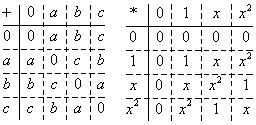 1: - Trinity In Christ
Let us make a start then. The Klein four-group has, as its name suggests, four elements. As a group it obeys the group axioms and it is also a group comprised of prime power cyclic factors of order 2, and is therefore isomotrphic to the additive group of the finite field of order two. We will consider the operations of the finite field upon the Klein four group.
Here are the tables for the operations of addition "+" and multiplication, "*". (Multiplication in a finite field)

Alternatively we may consider the elements as 0, 1, x and x+1 when addition is performed with coefficients modulo 2, (The remainder on dividing by two - why there is "only 0 and 1") and multiplication likewise with the extra condition that we take the remainder when dividing any products by an irreducible polynomial with coefficient modulo two. x2 + x + 1 is such a polynomial. (Try putting the values 0 and 1 as the values of x, and not that any root of this polynomial could not be in The field of two elements only, our "0 and 1". - The equation does not equal zero for either value.)
The important thing to note is that the multiplicative group is also cyclic, of order three. Multiplication appears to be similar to addition, but the exponents are computed "modulo 3" here. This is true in general for fields - For every prime power there is a unique (up to isomorphism) finite field of that order and the multiplicative group is cyclic.
Notice also that the additive group is composed of three elements - any of these could be our unity or "1". Any element is the product of the other two. We will simply state that as far as unity in the multiplication table is concerned: it is the product of the other two elements, Zero, we will not consider in this: although we will approach this element later.
Whichever non-zero member of the additive group we choose then, we will set as our "1" and make it both the product additively and multiplicatively of the other two. We therefore have three possible choices for unity, and only when we set a particular element as unity can we do this: There is an isomorphism between the two remaining states where the other two elements may switch in position. This automorphism can be generated multiplicatively by squaring each element before or after performing addition or multiplication.
A binomial expansion will easily show that coefficients of lesser powers in the product are 0 modulo 2, and we call this automorphism the Frobenius automorphism. It is a general state of affairs that all automorphisms of finite fields are obtained by repeated application of the Frobenius mapping, and to the power of its prime characteristic, and there are in number an equal number of possible automorphisms (including self to self) as the degree of the field extension. (4 is two squared, hence two automorphisms. A field of order 27 would be of degree three over its prime subfield, and there would be three such automorphisms.)
It is true in general that Every automorphism leaves a subfield fixed. Here it is the prime subfield, but there is also an automorphism of the field of 81 elements leaving a subfield of 9 elements fixed, as well as the prime subfield of three elements. However, this is only possible if there actually is a subfield of that order. The degree of the subfield over the prime subfield must divide the degree of the whole field over the prime subfield. Hence there is a subfield of order 8 in a field of order 64, but not a subfield of order four in a field of order eight, (Even though there is such a subfield in a field of order 64.)
So then, we consider our elements as members of the Klein four group. It would appear that there is an equivocation between the operations of addition and multiplication and the remaining two elements. This is not the case as we will see as we progress, rather the statement is one of "there exists a such and such". It is enough to see the symmetry that either additively or multiplicatively every unital choice is the product of the other two non-zero elements. We will move onto the case of the Octal group in the next page.
Continue To Next Page
Return To Section Start
Return To Previous Page |